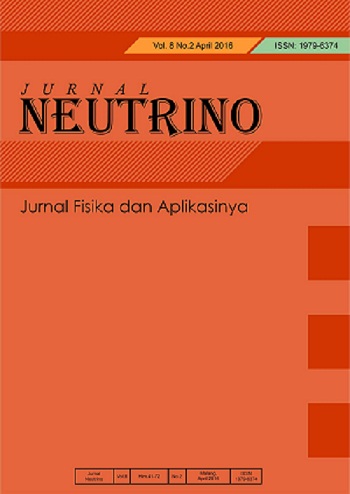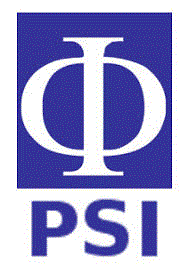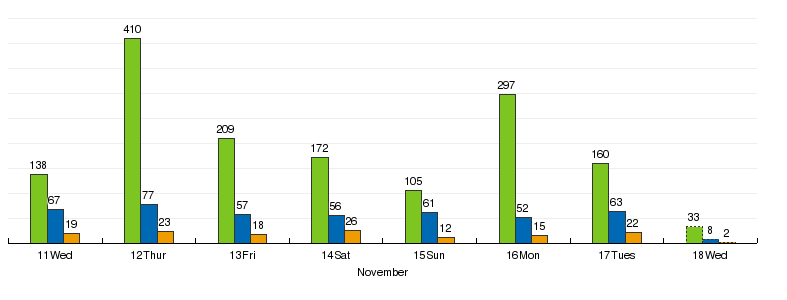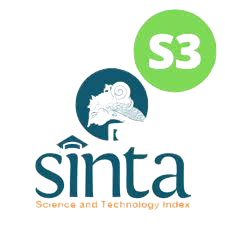EFFECT OF ADDITIONAL Ni METAL DOPANTS ON OPTICAL ABSORPTION PROPERTIES AND CRYSTAL STRUCTURE OF ZnO PHOTOCATALYST MATERIALS
Abstract
Keywords
Full Text:
PDFReferences
L.E. Doman, K.A. Smith, L.D. Mayne, E.M. Yucel, J.L. Barden, A.M. Fawzi, P.D. Martin, V.V. Zaretskaya, M.L. Mellish, D.R. Kearney, B.T. Murphy, K.R. Vincent, P.M. Lindstrom, M.T. Leff, 2010, International Energy Outlook 2010.
Badan Pusat Statistik. 2021. Sensus Penduduk 2020.
Daulbayev C, Sultanov F, Bakbolat B, Daulbayev O. 0D, 1D and 2D nanomaterials for visible photoelectrochemical water splitting. A Review. International Journal of Hydrogen Energy. 2020 Nov 27;45(58):33325-42.
Pavithra M, Raj MJ. Influence of ultrasonication time on solar light irradiated photocatalytic dye degradability and antibacterial activity of Pb doped ZnO nanocomposites. Ceramics International. 2021 Nov 15;47(22):32324-31. https://doi.org/10.1016/j.ceramint.2021.08.128
Ahmad I, Ahmed E, Ahmad M, Akhtar MS, Basharat MA, Khan WQ, Ghauri MI, Ali A, Manzoor MF. The investigation of hydrogen evolution using Ca doped ZnO catalysts under visible light illumination. Materials Science in Semiconductor Processing. 2020 Jan 1;105:104748.
Manzoor MF, Ahmed E, Ahmad M, Ahmad I, Rana AM, Ali A, Ghouri MI, Manzoor MS, Aziz MT. Enhanced photocatalytic activity of hydrogen evolution through Cu-incorporated ZnO nanocomposites. Materials Science in Semiconductor Processing. 2020 Dec 1;120:105278.
Ghorbani M, Abdizadeh H, Taheri M, Golobostanfard MR. Enhanced photoelectrochemical water splitting in hierarchical porous ZnO/Reduced graphene oxide nanocomposite synthesized by sol-gel method. International Journal of Hydrogen Energy. 2018 Apr 19;43(16):7754-63.
Desai MA, Vyas AN, Saratale GD, Sartale SD. Zinc oxide superstructures: recent synthesis approaches and application for hydrogen production via photoelectrochemical water splitting. international journal of hydrogen energy. 2019 Jan 22;44(4):2091-127.
Lin CC, Li YY. Synthesis of ZnO nanowires by thermal decomposition of zinc acetate dihydrate. Materials Chemistry and Physics. 2009 Jan 15;113(1):334-7.
Wu M, Chen WJ, Shen YH, Huang FZ, Li CH, Li SK. In situ growth of matchlike ZnO/Au plasmonic heterostructure for enhanced photoelectrochemical water splitting. ACS applied materials & interfaces. 2014 Sep 10;6(17):15052-60.
Gnanamozhi P, Renganathan V, Chen SM, Pandiyan V, Arockiaraj MA, Alharbi NS, Kadaikunnan S, Khaled JM, Alanzi KF. Influence of Nickel concentration on the photocatalytic dye degradation (methylene blue and reactive red 120) and antibacterial activity of ZnO nanoparticles. Ceramics International. 2020 Aug 1;46(11):18322-30.
Donkova B, Vasileva P, Nihtianova D, Velichkova N, Stefanov P, Mehandjiev D. Synthesis, characterization, and catalytic application of Au/ZnO nanocomposites prepared by coprecipitation. Journal of materials science. 2011 Nov;46:7134-43.
Ahmad I, Ahmed E, Ahmad M, Akhtar MS, Basharat MA, Khan WQ, Ghauri MI, Ali A, Manzoor MF. The investigation of hydrogen evolution using Ca doped ZnO catalysts under visible light illumination. Materials Science in Semiconductor Processing. 2020 Jan 1;105:104748.
Bordbar M, Forghani-Pilerood S, Yeganeh-Faal A, Khodadadi B. Effect of morphology on the photocatalytic behavior of ZnO nanostructures: low temperature sonochemical synthesis of Ni doped ZnO nanoparticles. Journal of Nanostructures. 2016 Jul 1;6(3):190-8.
Singh B, Kaushal A, Bdikin I, Saravanan KV, Ferreira JM. Effect of Ni doping on structural and optical properties of Zn1− xNixO nanopowder synthesized via low cost sono-chemical method. Materials Research Bulletin. 2015 Oct 1;70:430-5.
Kandjani AE, Tabriz MF, Pourabbas BJ. Sonochemical synthesis of ZnO nanoparticles: The effect of temperature and sonication power. Materials Research Bulletin. 2008 Mar 4;43(3):645-54.
Singh B, Kaushal A, Bdikin I, Saravanan KV, Ferreira JM. Effect of Ni doping on structural and optical properties of Zn1− xNixO nanopowder synthesized via low cost sono-chemical method. Materials Research Bulletin. 2015 Oct 1;70:430-5. Available from:
http://dx.doi.org/10.1016/j.materresbull.2015.05.009
Agus SA, Sudaryanto S. Penambahan N Pada TiO2 dan Pengaruhnya Pada Energi Band Gap TiO2 Sebagai Bahan Pengolah Limbah. InProsiding Seminar Nasional Teknologi dan Aplikasi Reaktor Nuklir 2016 (pp. 59-64).
Bouaoud A, Rmili A, Ouachtari F, Louardi A, Chtouki T, Elidrissi B, Erguig H. Transparent conducting properties of Ni doped zinc oxide thin films prepared by a facile spray pyrolysis technique using perfume atomizer. Materials Chemistry and Physics. 2013 Jan 15;137(3):843-7. Available from:
http://dx.doi.org/10.1016/j.matchemphys.2012.10.023
Raj IL, Christy AJ, Prabu RD, Chidhambaram N, Shkir M, AlFaify S, Khan A. Significance of Ni doping on structure-morphology-photoluminescence, optical and photocatalytic activity of CBD grown ZnO nanowires for opto-photocatalyst applications. Inorganic Chemistry Communications. 2020 Sep 1;119:108082. https://doi.org/10.1016/j.inoche.2020.108082
Gnanamozhi P, Renganathan V, Chen SM, Pandiyan V, Arockiaraj MA, Alharbi NS, Kadaikunnan S, Khaled JM, Alanzi KF. Influence of Nickel concentration on the photocatalytic dye degradation (methylene blue and reactive red 120) and antibacterial activity of ZnO nanoparticles. Ceramics International. 2020 Aug 1;46(11):18322-30.
https://doi.org/10.1016/j.ceramint.2020.05.054
Samanta A, Goswami MN, Mahapatra PK. Magnetic and electric properties of Ni-doped ZnO nanoparticles exhibit diluted magnetic semiconductor in nature. Journal of alloys and compounds. 2018 Jan 5;730:399-407.
Available from: https://doi.org/10.1016/j.jallcom.201.09.334
Rajbongshi BM, Ramchiary A, Samdarshi SK. Influence of N-doping on photocatalytic activity of ZnO nanoparticles under visible light irradiation. Materials Letters. 2014 Nov 1;134:111-4.
Sharifalhoseini Z, Entezari MH, Jalal R. Direct and indirect sonication affect differently the microstructure and the morphology of ZnO nanoparticles: Optical behavior and its antibacterial activity. Ultrasonics sonochemistry. 2015 Nov 1;27:466-73.
DOI: https://doi.org/10.18860/neu.v15i2.17514
Refbacks
- There are currently no refbacks.
Copyright (c) 2023 Istiroyah Istiroyah, H. Harsono, M. Nurhuda, T.S. Utami, A.A. Dardiri, Y. Engge, F. Maulana

This work is licensed under a Creative Commons Attribution-NonCommercial-ShareAlike 4.0 International License.
Published By:
Program Studi Fisika Fakultas Sains dan Teknologi Universitas Islam Negeri (UIN) Maulana Malik Ibrahim Malang, Indonesia
B.J. Habibie 2nd Floor
Jl. Gajayana No.50 Malang 65144
Telp./Fax.: (0341) 558933
Email: neutrino@uin-malang.ac.id
This work is licensed under a Creative Commons Attribution-NonCommercial-ShareAlike 4.0 International License
View My Stats











